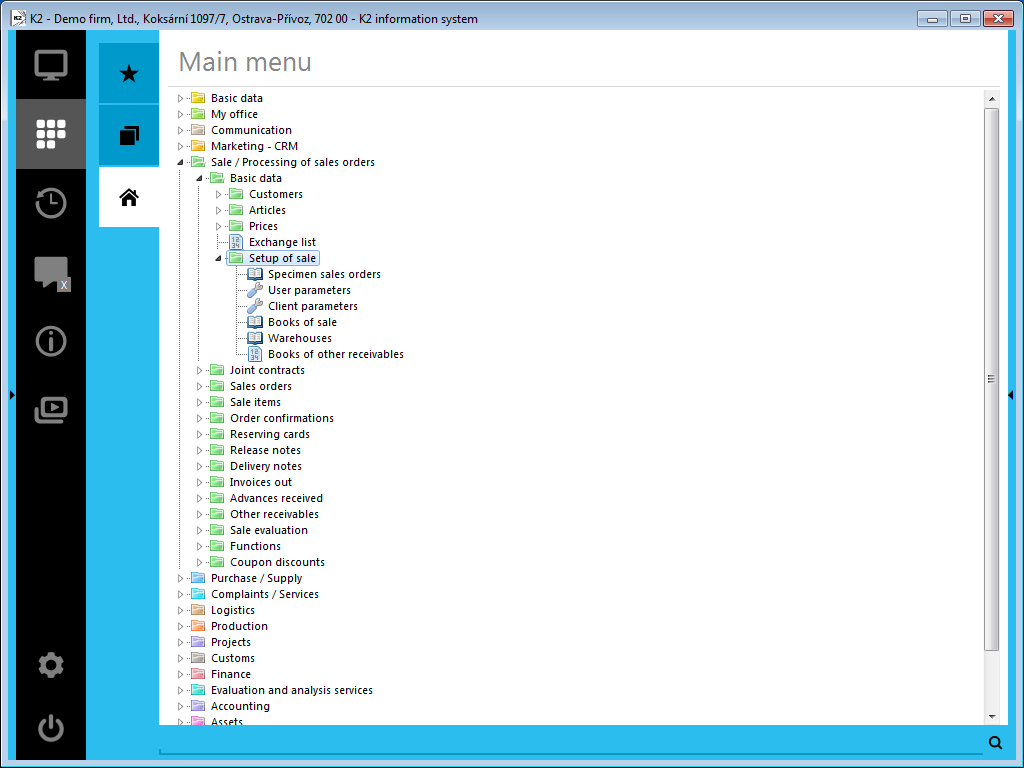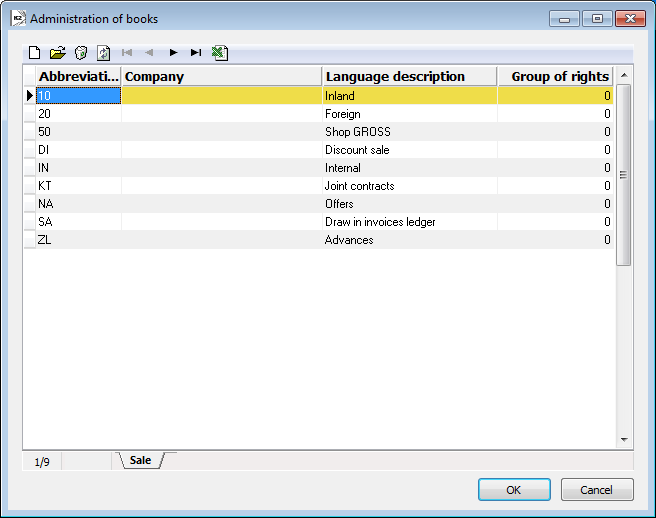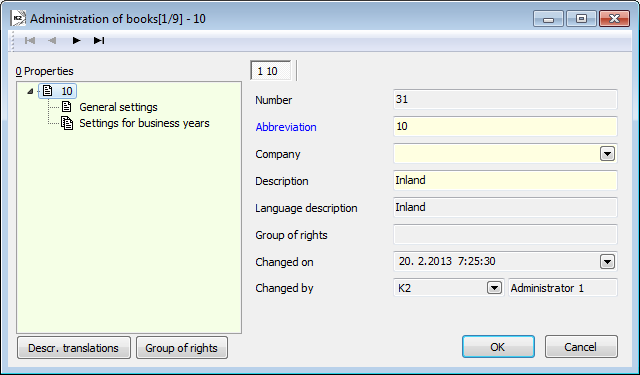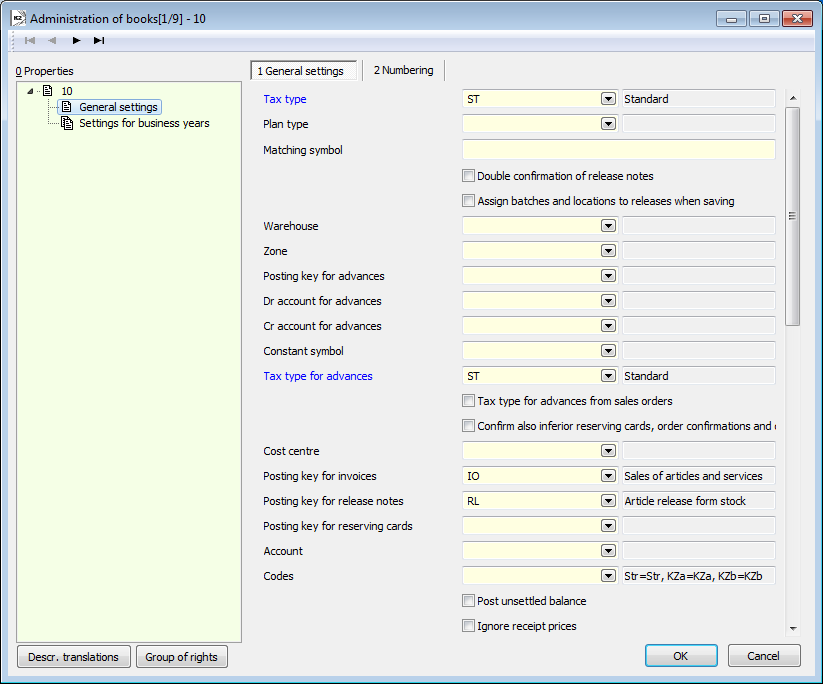Settings of Sale
In the Settings of Sale section, you may open the individual books and forms in which you can pre-set the data necessary for work with the Sale module.

Picture: The open menu of the Sale / Processing of Sales Orders - Basic Data - Settings of Sale module
Sales Order Specimens:
Activating this function will first open the book of Sales Orders and then the book of Sales Order specimens. You can create a new Sales Order from a specimen by moving the light indicator on the given item and pressing Enter.
Books of Sale
Sales documents are registered and divided into books of Sale. Book records can be found in The Books of Sale table. Books allow for even more detailed division by means of business years. The bulk changes on books of sale can be performed by using SaleBooksBulkChange.pas script.

Picture: The Books of Sale book
Description of the work with books, the settings principle and the description of page 0 are stated in the Administrator / Administration of Books chapter.

Picture: Books of Sale - page 0
Default Settings

Picture: Books of Sale - General Settings
Field description:
Type of Tax |
Tax type of invoice - selection from the Type of Tax table. |
Plan Type |
Pre-set plan type for documents. The detailed description is in the Basic Code Lists and Supporting K2 Modules - Plan Type chapter. |
Matching Symbol |
A matching symbol for Sales Orders. |
Double Confirmation of Release Notes |
If this option is activated, Release Notes are confirmed twice. The 1st confirmation executes the physical release of article from the stock record (the "CFExpe" field - Dispatch) - this article is not in the property of the company anymore, and the customer has not taken it yet. A document after the 1st confirmation is indicated by the icon |
Assign batches and locations to releases when saving |
On - when saving a Release Note, batches will be automatically inserted into each Release item by means of the FIFO method, which have the batch records and where no batch is inserted. K2 evaluates the order of batches for release according to the FIFO method on the basis of batch abbreviation created by the date of batch formation, and by the ordinal number in terms of a date. Assignment applies for locations as well. Only the location with the active option of Automatic Release is automatically inserted according to the location of the abbreviation. Off - the user must enter a batch and a location by him/herself upon release. The user can use the automatic assignment (as well as if this option was enabled) by pressing the Ctrl + F6 keys (on the 2nd page of Release note in the Change mode). |
Warehouse |
Preset warehouse for Release Notes. |
Zone |
Preset zone for Release Notes. The contents of the offer is filtered according to the set warehouse. |
Posting Key for Advances |
Posting Key for advance received - selection from the Posting Keys table. |
Dr Account for Advances |
Gross advance account- selection from The Chart of Accounts table. |
Cr Account for Advances |
Net advance account - selection from The Chart of Accounts table. |
Constant Symbol |
Constant symbol that will be automatically inserted into invoices out issued in the given book of sale. |
Book of Advances |
The book where the advance to a Sales Order will be created. Values (Posting key, accounts, Tax type...) will be inserted into a new advance according to the setting of the book that is entered in this field. If the field is empty, the advance will be created in the same book as the Sales Order. |
Tax Type for Advances |
Tax Type for Advances - selection from Type of Tax table. This tax type is pre-filled into an advance, unless the Tax Type for Advances from Sales Orders parameter is on. |
Tax Type for Advances from Sales Orders |
Presetting a Tax type for advances when creating an advance from a Sales Order. If the option is checked, a tax type from a Sales Order is pre-filled in the advance. If the option is not checked, a tax type from book of sale is prefilled in an advance. |
When confirming a Sales Order, it is also necessary to confirm the subordinate documents, Order Confirmations and Delivery Confirmations |
The option enables to automatically confirm selected subordinate documents when confirming a Sales Order. If the confirmation fails (e.g. the user has no permission), the program shows a message that the header contains an unconfirmed document. |
Cost centre |
This cost centre will be pre-filled into the newly created document (Ins). Linked documents take over cost centre from the superior document and upon pressing F6, the cost centre is copied from the original document. |
Posting Key for Invoices |
Posting key for invoices - selection from the Posting Keys table. |
Posting Key for Release Notes |
Posting key for Release Notes - selection from the Posting Keys table. |
Posting Key for Reserving Cards |
Posting key for Reserving Cards - selection from the Posting Keys table. |
Account |
Receivables account for posting of Invoices Out. Selection from The Chart of Accounts book If the account is defined, it is inserted into the Account field in an invoice out. |
Post Unsettled Balance |
This enables to book a Sale document in which the non-zero difference between the total amount on the document and the booked amount exists. |
Ignore Receipt Prices |
Presetting option for Release Notes. If this option on is activated on a Release Note, the receipts to a warehouse (negative items of a Release Note) are valued as a release (according to the method of evaluation of the appropriate warehouse). If this option is not set on a release note, then the defined stock price will be maintained for receipt items (the Stock recalculation function does not recalculate the receipt items of a release note). |
Excise tax - invoice |
By ticking the field, we will ensure that each newly created invoice in this book will have the ticked field Excise tax. |
Excise Tax - Release Note |
By ticking the field, we will ensure that each newly created release note in this book will have the ticked field Excise tax. |
VAT from Above |
Gross amount in items is set as default. Then VAT is calculated by coefficient set in VAT rates book and Net is calculated as difference between Gross and VAT amount. The field can be checked in the default book setting only. |
Set "tax doc." status on advances when paid in full |
By ticking the field, we will ensure that the advance after the payment goes to the "tax document" status. |
Accounting Transaction Date |
It presets Acc. trans. date when issuing invoice - the current date, the date from Delivery date field in sales order or the date of release (ie. the date of release note confirmation) can be set. |
Invoice Date |
It sets the Invoice date when issuing the Invoice out and Advance received and updates the Invoice date when changing Acc. trans. date. It is recommended to set 'Null date' in Books of Sale where the Credit notes are being created. |
Contract Code |
Preseting contract code for documents. |
Book of Service Documents |
Set the book of service sheets. If the service sheet is created from a Sale item (Ctrl + Shift + F8), the service sheet will be created into the book entered in this parameter. |
VAT Reg. No. of Own Company |
VAT Reg. No. entered in this field automatically appears on the own company details on the reports, which are printed on documents from this book. The field is to be filled in only if we have the VAT reg. No. registration in another country, and in this book we will issue the documents belonging to the VAT declaration of that other state. |
Internal Sales Orders |
If this option is active, the so-called "Internal Sales Order" will be created in the given book; these Internal Sales Orders represent a document which creates an internal request for production of a product or a semi-finished product. Closer description is provided in the chapter Internal Sales Orders - Internal Reservation for Production. |
Default Priority for Production |
Presetting of a priority for production. The value is transferred to an item of the Sales Order that is created in the selected book of sale and is then transferred to the Job Card header. |
Auto Creation of Contract Code for Sales Orders (Applies to Contract Code, Template) |
Setting a template for creating the contract code can provide auto creation of a contract code into the Sales Orders documents. A contract code by template is created when saving a new Sales Order document, and it replaces the code on the document heading and on its items, which is defined as a code for transcription (the Applies to Contract Code field). On items where the flag of a Release Note is assigned before saving the Sales Order, the code is not replaced. The contract code created according to the template has an internal flag that defines it as an automatically generated code. When copying a Sales Order which contains such a code (in the header or in items), a new code, which is designated as a transcription code, is entered into the new Sales Order, and then a new code according to the template is created when saving a new Sales Order. The template is created using the standard parameters of the "at signs", as well as e.g. the reference number definition. Example: @KN()@OB(2)@CI(N04) create the contract code in the full number of the Sales Order format (book + business year + number of the Sales Order completed by zeros to four signs). |
For the first item of sales order create |
In this column, you can set which documents of Sale should be created when inserting the first item of a Sales Order. You can check the random combination of documents. |
Priorities |
In this section, you can set the sequence of confirmation of Sale documents. A document with a lower number must be confirmed before the document with a higher number. If you confirm the document with a higher number earlier, a message saying that it is necessary to confirm a document with the lower number at first will appear. The exception upon evaluating are items of an Article category which prohibits the assignment to some document. In this case, the existence of a document is not evaluated and the confirmation of a following document is enabled. Note: You can only break the priority if you are authorized by the Break Priorities of Documents from Book right in the Sale - General section. |
Variable Symbols |
Here you can predefine the Reference Numbers that will be inserted into the documents when creating a Sales Order, an Order Confirmation or an Invoice Out. A reference number can be composed of the fixedly specified characters or with using the variable parameters "at-signs".
Supported parameters: 1) @CI(N0Y): fills in the document number and further completes this number by zeros to the specified number of characters. The (N0Y) represents the number of digits of how many places (determined by the Y value) the document number will be completed by zeros (determined by the 0 character). For instance, when setting the 4002@CI(N07) and the 1256 being the number of a document for which a reference number should be created, then the reference number will be: 40020001256. 2) It is possible to set the definition of the reference number as to not fill the Invoice number by zeros to the specified number of characters. The definition has to be entered in this way: @CI(N00). The second defined zero means that the filling of zeros (the first defined zero) is cancelled. 3) @KO(1 up to 12): a Contract Code is entered, the numbers 1 up to 12 define how many characters from the abbreviation of a Contract Code will be used. 4) @ST(1 up to 12): a Cost Centre is entered, the numbers 1 up to 12 define how many characters from the abbreviation of a Cost Centre will be used. 5) @OB(1, 2 or 4): fills in the business year. The number 1 determines that the year will be expressed in one number (e.g. the year 2014 will be expressed by the number 4). The number 2 determines that the year will be expressed in two digits (e.g. 14). Number 4 determines that the year will be expressed in integer (e.g. 2014). 6) @KN(): fills in the book of the document. It is necessary to enter a parameter including brackets; however, no values are written into the brackets.
It is possible to combine these strings in a definition (also with the constant numbers), but the maximal length of a string is 20 characters per definition. For example: @OB(4)@CI(N07). At the same time, there are also the English equivalents implemented for each string: @CI = @NO, @KO = @CC, @ST = @CE, @OB = @PE, @KN = @BO
If all fields of Variable Symbols stay empty, a VS will be automatically filled only into an Invoice in the @CI(N07) format. A Variable Symbol is created when saving document. |
 The second confirmation will make a release from the dispatch. From the accounting point of view, the date of first confirmation is the decisive factor for Release Notes.
The second confirmation will make a release from the dispatch. From the accounting point of view, the date of first confirmation is the decisive factor for Release Notes.